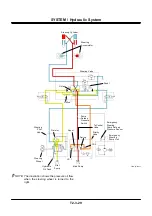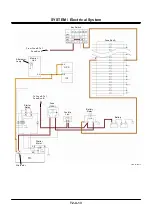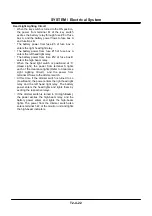
SYSTEM / Electrical System
T2-4-8
STARTING CIRCUIT (KEY SWITCH:
START)
FNR Lever in Neutral
•
When the key switch is turned to the START
position, terminal B is connected to terminals M
and ST inside the key switch.
•
As current from terminal M excites the battery
relay through fuse #8 of fuse box A, the battery
power is routed from the battery relay to terminal
#30 of the starter motor and terminal B of the
starter relay.
•
Current from terminal ST of the key switch flows
to terminal S of the starter relay and the coil inside
through the neutral relay.
•
The starter relay is turned ON and current flows to
terminal #50 of the starter from terminal C of the
starter relay.
•
Consequently, the relay inside the starter is
turned ON and the starter motor rotates.
•
Current from terminal M of the key switch flows to
all the controllers as a signal that the key switch is
in ON or START.
Operation of Starter Relay
•
When the key switch is turned to the START
position, continuity between terminals B and ST of
the key switch is made. Current flows to the base
of transistor Q2 through resistance R4 inside the
starter relay. Transistor Q2 is turned ON and
current flows to coil L of the relay.
Consequently, terminals #30 and #50 of the
starter are connected and the starter is operated.
•
When the engine is started, the alternator begins
charging and the voltage at terminal R of the
starter relay increases.
•
When this voltage reaches 21 to 22 V, Zener
diode Z is turned ON. Consequently, transistor Q1
is turned ON transistor Q2 is turned OFF as no
current flows to the base of transistor Q2.
At this moment, continuity between terminals #30
and #50 of the starter is lost and the starter is
turned OFF.
Condenser C1 is used to stabilize the operating
voltage. Diode D4 protects the circuit in case the
battery terminals are reversely connected.
T4GD-02-04-017
S
R
E
From Terminal L
of Alternator
Starter Relay
R
2
D
4
C
1
Z
C
R
3
D
2
(1)
(2)
R
4
(2)
Q
1
D
3
L
Q
2
(1)
B
C
B
ST
30
50
M
Starter
Key Switch
Ba
tte
ry
12V
12V
Neutral Relay
Summary of Contents for ZW180
Page 1: ......
Page 2: ......
Page 8: ...4GDT 1 2 Blank ...
Page 10: ...GENERAL Specification T1 1 2 Blank ...
Page 38: ...GENERAL Component Specifications T1 3 14 Blank ...
Page 39: ...MEMO ...
Page 40: ...MEMO ...
Page 42: ...4GDT 2 2 Blank ...
Page 56: ...SYSTEM Control System T2 1 14 Blank ...
Page 82: ...SYSTEM Control System T2 1 40 Blank ...
Page 92: ...SYSTEM Control System T2 1 50 Blank ...
Page 106: ...SYSTEM Control System T2 1 64 Blank ...
Page 116: ...SYSTEM ECM System T2 2 10 Blank ...
Page 128: ...SYSTEM Hydraulic System T2 3 12 Blank ...
Page 147: ...SYSTEM Hydraulic System T2 3 31 Blank ...
Page 150: ...SYSTEM Hydraulic System T2 3 34 Blank ...
Page 184: ...SYSTEM Electric System T2 4 34 Blank ...
Page 185: ...MEMO ...
Page 186: ...MEMO ...
Page 195: ...COMPONENT OPERATION Pump Device T3 1 7 Blank ...
Page 212: ...COMPONENT OPERATION Control Valve T3 2 4 T4GB 03 02 003 1 2 3 4 5 7 8 9 10 11 7 6 ...
Page 214: ...COMPONENT OPERATION Control Valve T3 2 6 T4GB 03 02 003 1 2 3 4 5 7 8 9 10 11 7 6 ...
Page 226: ...COMPONENT OPERATION Control Valve T3 2 18 Blank ...
Page 232: ...COMPONENT OPERATION Control Valve T3 2 24 Blank ...
Page 248: ...COMPONENT OPERATION Steering Pilot Valve T3 4 6 Blank ...
Page 258: ...COMPONENT OPERATION Steering Valve T3 5 10 Blank ...
Page 274: ...COMPONENT OPERATION Pilot Valve T3 6 16 Blank ...
Page 282: ...COMPONENT OPERATION Pilot Valve T3 6 24 Blank ...
Page 299: ...COMPONENT OPERATION Ride Control Valve T3 8 5 Blank ...
Page 306: ...COMPONENT OPERATION Ride Control Valve T3 8 12 Blank ...
Page 348: ...COMPONENT OPERATION Drive Unit T3 9 42 Blank ...
Page 371: ...MEMO ...
Page 372: ...MEMO ...
Page 374: ......
































